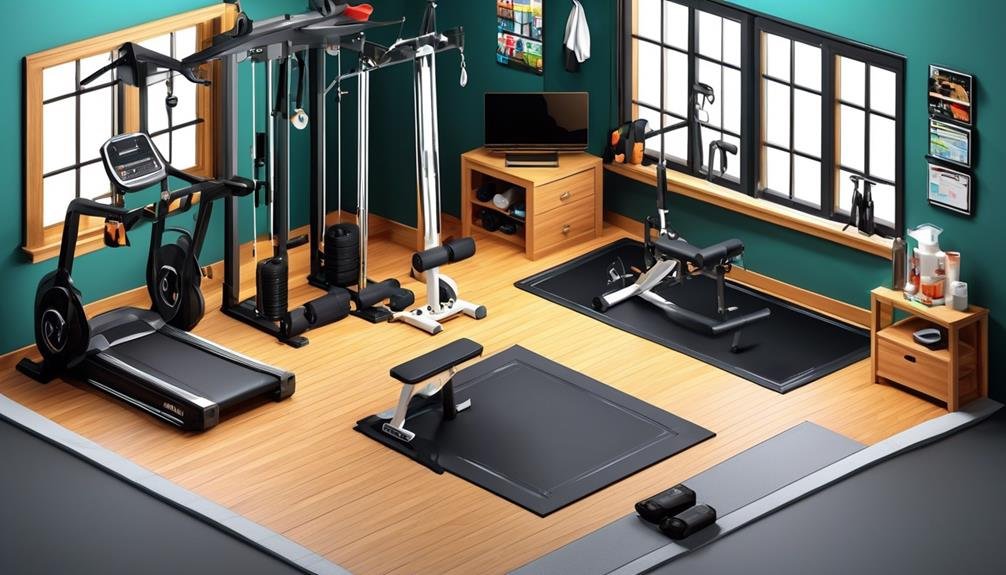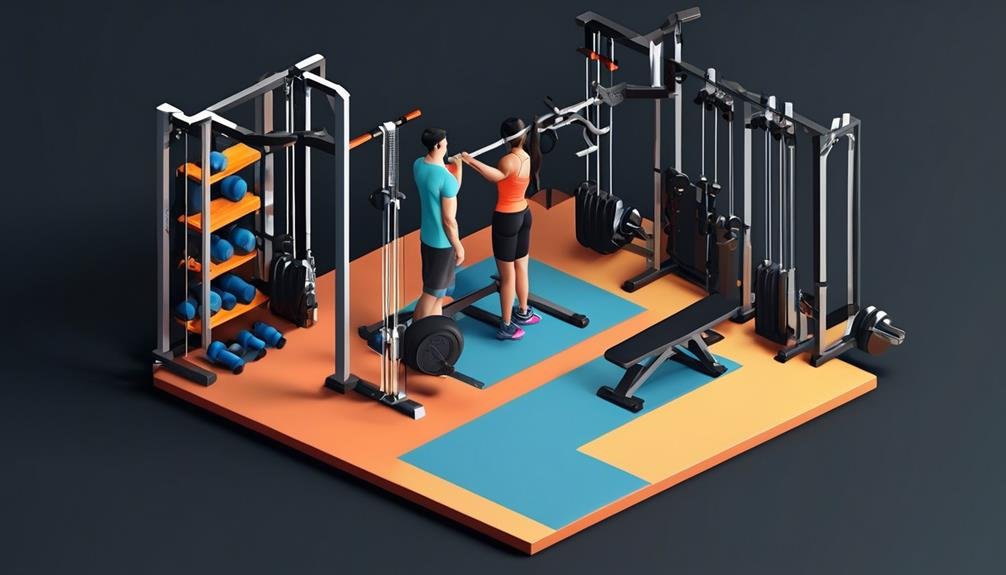Are you ready to embark on your fitness journey and make the most of your home gym equipment? Before you jump right in, it's crucial to understand the importance of injury prevention. Injuries can derail your progress and hinder your motivation.
But fear not, because in this discussion, we will explore effective strategies to keep you safe and injury-free. So, let's dive into the world of warm-up techniques, equipment safety, creating a safe workout environment, professional guidance, and starting slow.
By implementing these practices, you'll be on your way to a successful and injury-free fitness journey.
Key Takeaways
- Engage in a proper warm-up routine before using home gym equipment to prevent injury.
- Familiarize yourself with the functions and safety features of each equipment and follow proper usage guidelines.
- Create a safe workout environment by understanding your body's limitations, consulting with a personal trainer, and scheduling rest days for recovery.
- Consider seeking professional guidance or training to learn proper techniques, form, and injury prevention strategies when using home gym equipment as a beginner.
Proper Warm-Up Techniques
To prevent injury and optimize your workout, it's crucial to properly warm up before using home gym equipment as a beginner. Warm-up techniques play a vital role in injury prevention and ensuring your body is prepared for exercise.
Engage in dynamic warm-up exercises such as butt kickers, high knees, leg swings, and side steps to increase blood flow and prepare your muscles. Incorporating foam rolling and using acupressure balls can help loosen up stiff muscles and improve circulation before starting your workout.
Gradually increase the intensity of your warm-up to prepare your body for more strenuous exercises, preventing strains and muscle pulls. Spend at least 10-15 minutes on warm-up exercises before engaging in high-intensity workouts to ensure your body is adequately prepared.
Focus on warming up the specific muscle groups you'll be using during your workout to optimize performance and reduce the risk of injury. Following proper warm-up techniques is essential for staying safe and getting the most out of your home gym equipment as a beginner.
Remember to consult expert advice and listen to your body, adjusting your warm-up routine based on your fitness level and goals.
Equipment Familiarity and Safety
Are you familiar with the functions and safety features of your home gym equipment? It's crucial to understand how to properly use your equipment in order to prevent injuries. Here are three important points to consider:
- Thoroughly understand the functions and safety features: Take the time to read the instruction manual and familiarize yourself with how each piece of equipment works. Pay attention to any safety guidelines provided by the manufacturer.
- Follow weight limits and proper usage: Each piece of equipment has weight limits and specific ways it should be used. Make sure you're aware of these limits and use the equipment accordingly. Using weights or resistance levels that are too heavy can lead to strain or injuries.
- Ensure proper assembly and stability: Before using any equipment, ensure that it's properly assembled and stable. Loose bolts or unstable frames can pose a safety risk. Take the time to regularly inspect your equipment for any signs of wear or damage.
Creating a Safe Workout Environment

Now that you have familiarized yourself with the functions and safety features of your home gym equipment, let's focus on creating a safe workout environment.
To prevent injuries while working out at home, there are a few key things you need to keep in mind.
First and foremost, always begin your workout with a proper warm-up. This will help increase blood flow to your muscles and prepare your body for the exercises ahead. A warm-up can include light cardio exercises like jogging or jumping jacks.
It's also crucial to understand your body's limitations. While it's important to challenge yourself during your workouts, it's equally important to avoid excessive stress or strain. Listen to your body and stop if you feel any sharp pain or discomfort.
Consider consulting with a personal trainer, especially if you're new to home exercise or strength training. A trainer can guide you through proper form and technique, reducing the risk of injury. They can also design a workout program that suits your fitness level and goals.
Don't forget to schedule rest days. Rest days allow your body to recover and prevent overexertion. This is particularly important when working on upper body strength exercises, as the muscles need time to repair and grow.
Lastly, maintain a clean and organized gym environment. Clear any clutter, ensure equipment is properly stored, and check for any potential hazards.
Considering Professional Guidance or Training
Consider seeking professional guidance from a certified fitness trainer to ensure safe and effective workouts. Here are three reasons why professional guidance is crucial when using home gym equipment as a beginner:
- Proper Techniques and Form: A certified fitness trainer can teach you the correct techniques and form for using fitness equipment and accessories. This knowledge is essential to help prevent injuries and ensure that you get the most out of your workouts.
- Tailored Workout Plan: Enlisting the help of a personal trainer allows you to create a workout plan that's tailored to your fitness level and goals. They can design a program that gradually challenges you while keeping you injury-free.
- Expert Advice on Injury Prevention: Professional trainers have the expertise to provide you with valuable advice on preventing injuries. They can guide you on safe movement execution, proper warm-up and cool-down routines, and how to listen to your body to avoid overexertion.
Starting Slow and Gradually Increasing Intensity

To ensure a safe and effective workout, it's important to start slow and gradually increase the intensity when using home gym equipment as a beginner. Starting with lighter weights and lower resistance allows your body to adapt to the movements and avoid strain. By gradually increasing the duration and intensity of your workouts, you can prevent overexertion and reduce the risk of injury. It's crucial to give your body time to adjust and build strength without overwhelming your muscles and joints. Pay attention to how your body responds and adjust the intensity based on how you feel to avoid pushing yourself too hard. This approach of starting slow and gradually increasing intensity allows for a safer and more sustainable workout routine as a beginner.
| Benefits of Starting Slow and Gradually Increasing Intensity |
|---|
| 1. Allows your body to adapt to the movements and avoid strain |
| 2. Reduces the risk of overexertion and injury |
| 3. Gives your body time to adjust and build strength |
| 4. Helps prevent overwhelming your muscles and joints |
| 5. Provides a safer and more sustainable workout routine as a beginner |
Frequently Asked Questions
How Do I Start Working Out and Avoid Injuries?
To start working out and avoid injuries, focus on warming up to increase blood flow and flexibility. Know your limits and stop if you feel pain. Consult a trainer for guidance, take rest days, and keep your home gym clean and organized.
How Do I Not Injure Myself When Working Out?
To prevent injury when working out, start by understanding your body's limits, warming up properly, and consulting with a trainer. Remember to take rest days and keep your home gym clean and organized.
What Is Best Exercise Equipment for Beginner?
To prevent injury as a beginner using home gym equipment, start with lower-intensity routines and gradually progress. Seek guidance from a certified fitness professional and learn proper form for each exercise. Use equipment like a rowing machine or stationary bike for full-body workouts with low impact.
How Can You Reduce the Odds of Getting Injured During Exercise?
To reduce the odds of getting injured during exercise, listen to your body and don't push past your limits. Warm up properly, consult with a trainer, incorporate rest days, and keep your home gym clean and organized.
Conclusion
To prevent injury when using home gym equipment as a beginner, it's crucial to prioritize proper warm-up techniques. Familiarize yourself with the equipment and create a safe workout environment. Consider seeking professional guidance or training to ensure correct form and technique.
Start slow and gradually increase intensity, listening to your body's limitations. By following these steps, you can enjoy a safe and injury-free workout experience in your home gym.
